To celebrate Valentine’s Day this month, I’ll be writing on themes of love, passion, and marriage in the cards. For each weekly post, I’ve chosen some of my favorite cards that speak to each topic.
- Love: The Lovers, 2 of Cups, 6 of Cups, Temperance
- Sex: Devil, Knight of Wands, Knight of Swords, Ace of Wands
- Marriage: 4 of Wands, Hierophant, Justice, Queen of Swords
- Lovers-themed tarot decks (Today’s post!)
If you enjoyed this series and would like to follow my future work, I encourage you to sign up to receive email notification when a new post goes up by signing up on the top right of this page (totally free and you will only get notifications of my blog posts, published 4-5 times a month). If you’d like to subscribe to my once-a-month newsletter with notifications of classes, talks, meetup groups, special events, and a recap of my blog posts from the month, please sign up here or through my Facebook page.
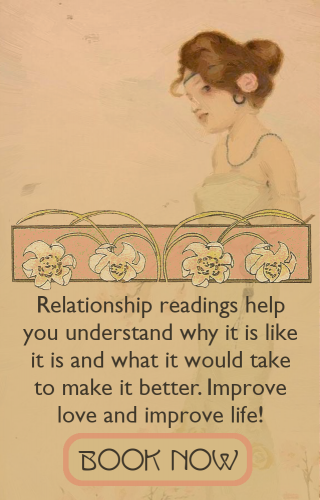
Tarot Decks for Lovers
If you’d like to get in the mood, using a special deck for questions of romance and love can tug at the heartstrings and stimulate the imagination, unleashing possibility. Tarot has an embarrassment of riches in beautiful and inspiring art–trying to choose the most romantic decks would be impossible. Add to that individual taste–what ratio do you prefer between affection, sensuality, and eroticism? For this post, I chose to focus on decks with beautiful artwork, sumptuous design, soft femininity, and imagination-priming story.
The Art of Love Tarot: Illuminating the Creative Heart by Denise Jarvie (Author), Toni Carmine Salerno (Artist)
I had to have this deck the second I saw the artwork, by very popular artist Toni Carmine Salerno. He’s created many well-loved oracle decks, but this is his first tarot deck, and so my first introduction to him. The deck author is Denise Jarvie and it’s published by Blue Angel Publishing.

The artwork is evocative and emotive. It is colorful without being gaudy, and full of voluptuous organic shapes composed of tiny geometric details. Gradient pastels, rich earth tones, and subtly blended jewel tones make up the palette. There are more female characters than male, but also many simple fantasy landscapes with no people. The cards are inviting, uplifting, intuitive, and radiating light.

Colored borders helpfully identify the suits, with light blue borders for the Suit of Angels (Air/Swords), pink for Suit of Hearts (Water/Cups), pastel green for Trees (Earth/Pentacles), and pale yellow for Stars (Fire/Wands). The Majors have a lavender border. Each card has a keyword, but I don’t always find that it matches the artwork. I dislike keywords because when I see people work with an unfamiliar deck that uses such labels, they focus on the words and neglect the imagery. While it’s normally frustrating to try to get people to dive into the imagery, I felt an even greater loss hearing people cut off their understanding of the card at the border. Such a waste in this playful and poetic deck.
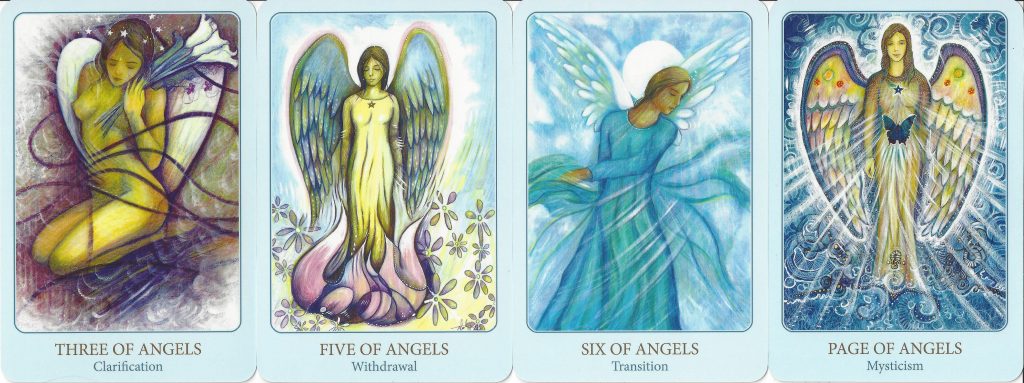
The product description says that author “Denise Jarvie was inspired to create this deck from seventy-eight of Toni’s most enchanting works,” implying that the art was not done for the deck. In fact, as I look at the cover images of some of the oracle decks on the artist’s site, I see images that I recognize from The Art of Love deck–so some of these images have been previously published in his earlier oracle decks. Due to this, I wonder how much, if any, original work appears in this deck.
One thing that I prefer in a tarot deck is that the suit icons (in this case, the hearts, trees, stars, etc.) be incorporated into the artwork, and when a deck is created from existing art this of course does not usually occur. In this deck, the suit icons appear on many but not all of the Minor Arcana cards. The Suit of Angels is the most remiss. Looking at the images above, you can see that the Three of Angels holds three calla lilies, and the Five of Angels stands in five violet flames. But the Six of Angels, and most of the other cards in that suit, do not have any indication of number in the artwork–for instance, if you cut the borders off, you would no longer know what the card is. Furthermore, several of the Angels cards have hearts or stars on them, making me feel like the Eight of Angels: Confusion. The overall result is that this deck reads much more like an oracle deck than like a tarot deck.

That said, oracle style tarot decks are becoming more and more popular (Dreams of Gaia Tarot, also published by Blue Angel, comes to mind), and I know that with the beautiful artwork and inviting environments, this deck will be one of the most popular in this crossover genre. Oracle decks tend to conjure emotion but not action. To my students, I describe scenic tarot card illustrations as “a person or animal doing something.” The people and rare instances of animals in this deck aren’t taking any actions, so I would classify this at the high functioning end of the spectrum we call moody or atmospheric pips–there is definitely a feel of place, of emotion, and of mood, but not often enough is there the kind of action needed to base a story on.
An example of an exception to this would be, for instance, the Two of Trees above. There are two trees, each with a heart in the earth below them. The trees connect at the root, branch into separate trunks, then lean into each other, embracing just below the canopy of leaves. This is a lovely image, very tender and full of renewal. It is also full of memory for me. There was a time in my life when I wanted very much to be in a relationship, and every time I saw two trees growing from a single root, especially those whose trunks intertwined, I saw it as a sign that it was possible. It’s fulfilling to see this image come around again at a very different time in my life.
There is a deep and simple affection shown in this deck. It’s easy to feel an emotional response to each card, and this deck would work very well for an intuitive reader who starts with the image but from that jumping off point finds meaning through psychic techniques. For the modern tarot reader who depends on active scenes, you might find yourself hypnotized by the beauty of the images, but mute when it comes to speaking their story.

The Lover’s Path Tarot by Kris Waldherr
I love Kris Waldherr’s art. You might know her from the very popular Goddess Tarot. She’s also the creator of the Sacred World Oracle (one of my very few oracle decks!), as well as the Doomed Queens Playing Cards deck and the Ask the Queens Advice Cards, which according to the product description “offers wisdom for women who want to get ahead without losing their heads.” Her website is well worth checking out not only to see her books, children’s books, and other products, but because she offers a really nice free reading software on her site, so you can do sample readings with any of her decks and familiarize yourself with them before buying. You can choose from ten spreads, and based on the type of spread, select from one or more of her decks to use for it.
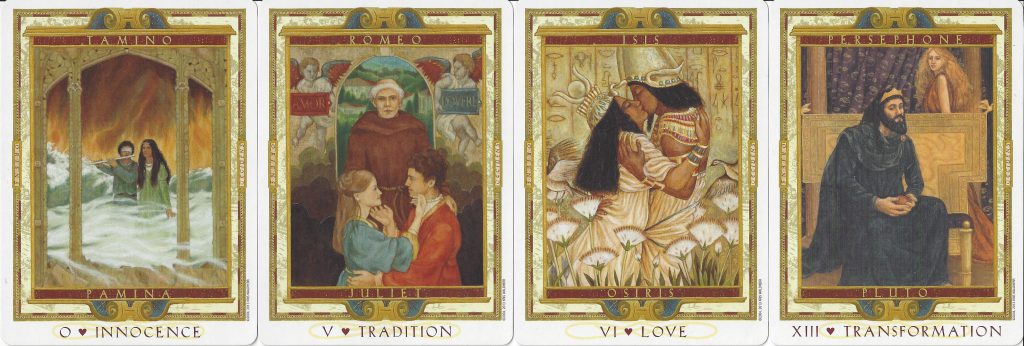
The Lover’s Path Tarot is based on love stories from myth, legend, literature, the arts, and history. Each card of the Major Arcana features a well-known couple such as Tamino and Pamina (0 Innocence, from Mozart’s Magic Flute), Romeo and Juliet (V Tradition, from the play by Shakespeare), Isis and Osiris (VI Love, from Egyptian mythology), and Persephone and Pluto (XIII Transformation, from Greek mythology). The choice of myths is weighted strongly toward Greek mythology, backed up with some other European stories, and very little wandering beyond those borders. If you studied Greek mythology as a child like I did, you’ll recognize a fair number of the stories. The LWB helpfully gives us a short paragraph on each story for the Majors so we can get up to date on the ones we don’t know.
The artwork is gorgeous, establishing the era of the story, and, accordingly, showcasing costuming from classical times through medieval and Renaissance periods, including lots of long gowns and gracefully draped fabric. There is much tenderness and affection illustrated, as well as all the array of passions from loss and suffering to anger and vengeance to keen desire, the emotions one would expect in a love story. Each scene shows not only the details of the characters, but a depth of perspective in the background, offering hints to the environmental influences, such as crashing waves, verdant rolling hills, dark woods, or distant cities.
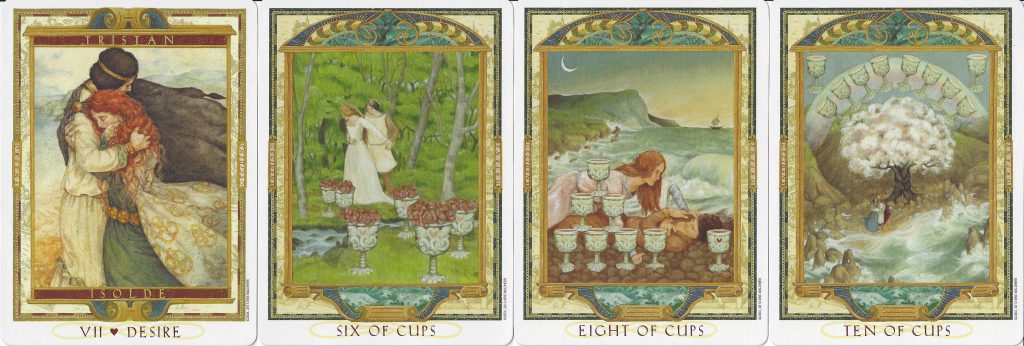
Interestingly, each suit tells one love story in depth. The Suit of Cups is Tristan and Isolde (Celtic legend), Staves (Wands) is Siegfried and Brunnhilde (Norse mythology), Arrows (Swords) is Cupid and Psyche (Greek mythology), and Coins (Pentacles) is Danae and Zeus (Greek mythology). The court cards of the suit reflect the major players, and the pips tell the related story. This would be a deck that would benefit from an in-depth guidebook. The LWB doesn’t even attempt to describe the scenes in the pip cards. Of course, the myths are common enough to find through other sources, but for instance, although I followed Danae and Zeus well enough up through the Four of Coins, my memory faltered with the remaining cards and when I pulled up a reliable source for Greek mythology, the story described there did not seem to match the cards.
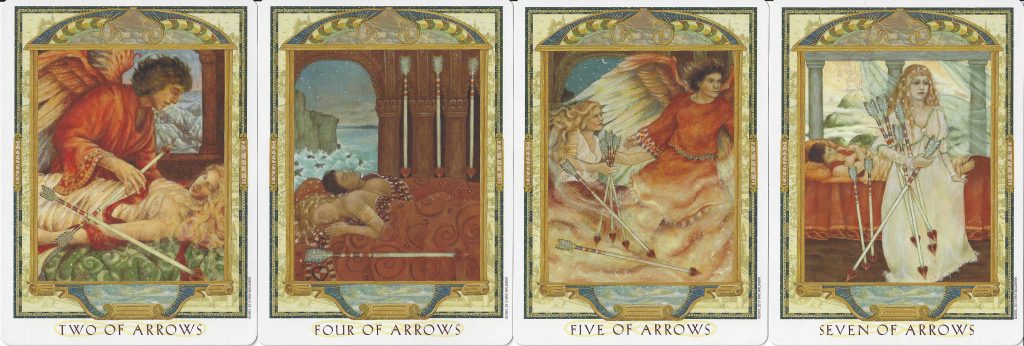
However, this is only a minor problem for a few reasons–first, the cards follow the standard RWS (Rider Waite Smith) imagery reasonably well, enough that you can fall back on traditional imagery if you’ve lost the thread of the story. (In fact, annoyingly, the LWB only offers standard RWS meanings for the pips and doesn’t even address the artwork in the deck.) Secondly, even if you don’t know the story, you can piece together important points from the artwork, which is the reason deck creators use scenic illustrations in cards (otherwise we’d all prefer to use pip-based decks!). If you’re unfamiliar with the story, it offers motivation to learn more about mythology. Lastly, I did a reading with a friend using this deck right out of the box, and even though I hadn’t yet even realized that the pips were following a specific storyline, we gathered wonderful detail in a way that answered my question with surprising but relevant insight–the sign of a very usable deck. Due to the depth of symbolism, I find it helpful to focus on spreads with fewer cards so I can explore each one in depth. Large spreads quickly get overwhelming.
This deck reads beautifully using the standard story-telling techniques that all modern tarot readers are taught. And its depth of symbolism and layers of meaning offer up vast vistas to explore in the expansive and lush landscapes painted by Kris Waldherr and the eternally relevant truths from millennia-old stories.
The Victorian Romantic Tarot by Alex Ukolov, Karen Mahony
Although currently out of print, the Baba Studios website assures us that a new edition is in the works, and I can’t imagine this beautiful, popular, and easy to read deck will ever go out of print for too long–just long enough to remind us how much we love it!

I have the first edition, which the website assures me is quite different from the second edition–new images were designed for twenty of the cards. The site goes on to say, “We feel that the narrative power of the deck is now stronger than ever, and the new imagery is more fluid visually, and brings some interesting new interpretive possibilities.” I have to admit I didn’t realize the second edition was different or I would have bought it was well! I’ll have to wait for the new version to come out.

I have always found this deck to be wonderfully readable, and it’s easy to see the standard RWS meanings in most of the images. My understanding is that this is a collage deck built from the artwork of 19th century engravings. Although as I rule I dislike collage decks, in this case the artists use techniques that make each card coherent and natural so each appears to be simply its own piece of art.
The artwork expresses not only the historical time period of the Victorian era, but also the Neoclassicism and Romanticism that were popular at that time. Allusions to mythology and literature are Easter eggs to discover in some of the cards, but the illustrations are clear without any recognition of underlying themes. The coloring is beautiful, with highlights of pure, deep hues against more muted backgrounds. Landscapes, seascapes, cityscapes, and gritty street scenes form the environments, providing variety and adding depth. Men and women, old and young, friends and family from all classes of English and European life populate this deck.

Even though the RWS influence is strong, the images themselves have the scenic illustrations that make it easy to read the story of the spread even for new readers. The illustrations do not always include the suit icons (wands, cups, swords, pentacles) in the artwork, one of my requirements for a beginner deck, although many of the cards do. It would be easy to find meaning in these images for any reader, whether they are using traditional story-telling, intuitive techniques, or by following RWS meanings.

Some of my favorite cards are from the suit of Cups. In the Two of Cups, we peer unobtrusively into a meeting of lovers seated on a bench in a shadowy glade. The man, completely focused, leans in to the woman who gazes demurely downward, while two sherry glasses on the bench between them establish the appropriate decorum of distance. The image is full of intimacy, privacy, and attraction. The Four of Cups shows an outdoor party lit by colorful Japanese paper lanterns. A man in a tuxedo looks at a woman, wantonly lounging by the draped table, cup raised, while two other women hold him back, offering him wine. A fourth woman toasts from off to the side. What depravity and yearning we feel in this image! The Six of Cups is one of my all-time favorites (remember this post?). Two girls stand on a balcony overlooking a snow-covered city. One stretches slightly to peer over the railing down to the street below, while the second girl tugs at the first’s pinafore, looking up at some point of intrigue far above. We can’t see what either girl sees, opening up worlds of potential. The pull to be able to step into this card and look around is overwhelming. In fact, the call to step into each scene and experience it with the characters is a palpable invitation.
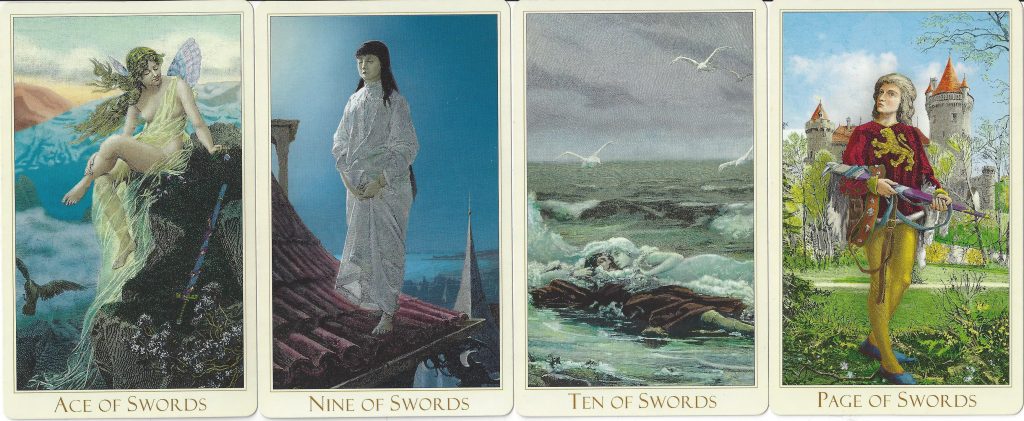
In just ten years’ time this deck has become a classic. Readable, imaginative, inviting, unique, suggestive, sometimes sensual, sometimes lonely, the images always conjure a vicarious response from the viewer. This is a lovely land to get lost in, and we find answers as we find ourselves.
What love themed tarot decks have you loved? Please share in the comments!






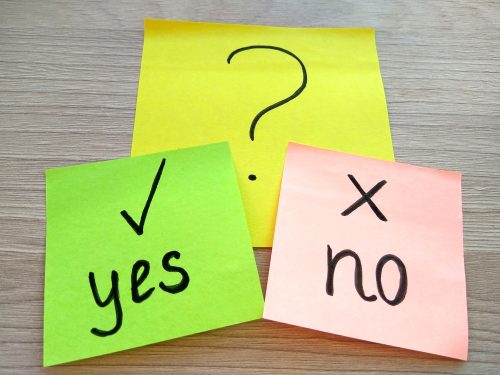

[…] Lovers-themed tarot decks […]
Thanks for the great review of thw deck s i did enjoy it. I had no idea they were out there. Do they have them at Isis? Always enjoyable read thanks for sharing.
Hi Patricia! Yes, the Lover’s Path Tarot is on the shelf at Isis Books & Gifts, and I think Fran has the Art of Love in the back but you’d need to ask her about it to be sure. The store is slammed at this very minute so I can’t get her attention to find out. You can also check the website: http://store.isisbooks.com/default.asp. They’re sold out of the Victorian Romantic so we just have to wait for the next reprint!
[…] Lovers-themed tarot decks […]